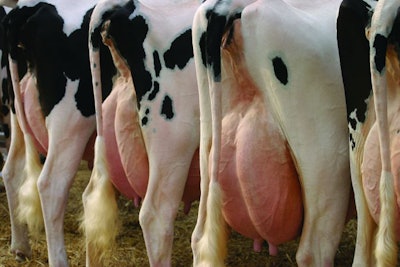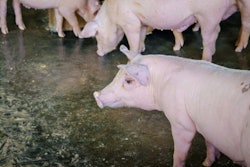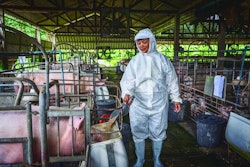
Dry cow management is essential for minimizing risk, but feeding strategies can help
Mastitis is considered to be one of the most costly dairy cattle diseases, making it highly relevant to dairy farmers. Mastitis is also one of the most common reasons for cows to be removed from the herd. The economic impact of this disease cannot be underestimated. The median loss of milk per mastitis case in a 35-day period around treatment has been estimated to be up to 164 kg.
Often, mastitis-associated losses are underestimated due to their non-definitive — and often non-clinical — symptoms, such as reduced milk production. Multiple factors contribute to mastitis and elevated somatic cell counts (SCC), ranging from environmental issues to the milking procedure to poor immune system function. Unfortunately, there is no magical solution that will prevent mastitis problems on farm. Given the reliance on antimicrobials for the treatment and control of mastitis, there is growing concern over the risk of antimicrobial resistance (AMR).
Causes of mastitis
Mastitis, as the name suggests, is inflammation in the mammary gland. While mastitis indicates inflammation, infection may not always be present; therefore, mastitis can be distinct from the term intramammary infection.
Causes of mastitis vary from infection to physical trauma. The leading cause of mastitis is bacteria. Yeasts and molds are sometimes implicated but account for only about 1% of cases. Infectious organisms invade the udder via the teat canal, migrating up through it and colonizing the secretory cells. These organisms can produce toxins that damage the milk-producing tissues, which reduces the ability to produce milk. The extent of colonization depends largely on the cow’s immune system.
The bedding used to house cattle is the primary source of environmental pathogens, but contaminated teat dips, intramammary infusions, water used for udder preparation before milking, water ponds or mud holes, skin lesions, teat trauma and flies have all been incriminated as sources of infection. The bacteria can also originate from already infected udders and replacement animals coming onto the farm. Streptococcus spp., Staphylococcus spp. and coliforms are the main culprits for mastitis, resulting in sub-clinical and clinical mastitis. For example, Staph. aureus is responsible for “summer mastitis.” However, a recent study found a shift in causative pathogens from those commonly associated with contagious mastitis, e.g. Staphylococcus aureus and Streptococcus agalactiae, toward those commonly found in the environment, such as Streptococcus uberis.
Mastitis passed from one cow to another is often termed as contiguous mastitis. Sub-clinical mastitis usually results from infection from the environment. All dairy herds have cows with subclinical mastitis; however, prevalence of infected cows varies from 5% to 75%, and quarters from 2% to 40%.
Interestingly, due to the changes that take place in mammary tissue, the primary time for animals to become infected is during the dry period, making adequate dry cow management essential for minimizing risk.
Mastitis development
The first line of defense is the teat. Normally closed, the teat canal opens during milking and remains so for a couple of hours, hence why it is important to keep the cow standing by offering feed and water. Organisms able to penetrate the teat canal during or shortly after milking can then potentially colonize the mammary tissues resulting in mastitis. These organisms may be present in the milk, the milking equipment, or on the end of the teat, e.g. picked up from bedding and/or manure.
When milk-secretory cells are damaged by infection, they release chemical signals, termed inflammatory mediators, that increase the permeability of capillaries and blood vessels. Other signals will attract white blood cells (leukocytes) to the site of infection to phagocytose the infecting bacteria. This serves to block ducts, trapping milk within the tissue. If the bacteria are completely destroyed by the leukocytes, infection can be eliminated and the animal recovers. However, if the bacteria are only partially destroyed, those remaining can enter structures deeper within the mammary gland.
Persistent infection and the resultant entrapped milk stimulate the secretory cells to change to a non-producing, or resting, state. No milk is produced and alveoli start to shrink. As the infection progresses, secretory structures are completely destroyed and replaced with non-secretory scar and connective tissues. Interestingly, destruction of these tissues is an attempt to control infection. The involvement of inflammatory cells, together with the destruction of local secretory tissues leads to the classic elevated SCC and reduction in milk yield seen in cases of mastitis.
 Dry cows are more susceptible to mastitis, so proper management and immune-boosting nutrition are essential to prevention. (Grafissimo | iStock.com)
Dry cows are more susceptible to mastitis, so proper management and immune-boosting nutrition are essential to prevention. (Grafissimo | iStock.com)Tackling mastitis
The fundamental principle of mastitis control is that the disease is controlled by either decreasing the exposure of the teat to potential pathogens or by increasing resistance of dairy animals to infection. Hygiene and housing management play crucial roles in reducing exposure to pathogens and promoting udder and teat integrity. Good hygiene during and after milking, e.g., teat dip or spray, correct functioning of the milking machine, e.g. ensuring the vacuum is at the correct level and not leaving the clusters on for longer than necessary, and cleaning udders goes a long way toward reducing the risk of infection. Treatment of teat ends is based on cleaning and drying of teats before milking and disinfection pre- and post-milking (pre-dipping and teat-dipping).
In heifers, poor hygiene in cow calving areas has been associated with an increased prevalence of high SCC with higher odds of becoming infected with environmental pathogens. Managing heifers on the same grazing as cows has also been implicated in increased chances a heifer will get mastitis. Hygiene and udder scoring are good, practical ways to assess cleanliness, as animals with poor scores can be 1.5 times more likely to have major pathogens isolated from milk samples compared with cleaner animals. Vaccinations are also available against certain bacteria, e.g. coliforms.
Dry cow management has long been a mainstay of mastitis control plans. The udder goes through significant physiological change during the dry period and, as such, can leave the cow highly susceptible to mastitis. It is commonplace to use antibiotics targeted toward Gram-positive bacteria and teat sealants in the dry period. This dry cow therapy can be blanket (treat all four quarters of all cows) or selective (treat only infected quarters/cows). The choice is down to individual preference and situation, however, with the issue of antimicrobial resistance and improvements in housing and feeding, blanket therapy may no longer be sustainable.
Mastitis control plan
Producers are encouraged to have a mastitis control plan that includes key areas of management to be implemented to try to reduce the risk of mastitis.
- Individual cow milk recording: This is the most crucial part of any mastitis program. Individual cow milk recording enables you to monitor the SCC of each cow over the course of the lactation. This information then allows you to identify cows with higher than average SCC and whether they are repeat offenders. It also aids in identifying animals likely to respond to dry cow therapy and those that should be culled.
- Early detection and prompt treatment: Once high SCC cows have been identified, it is crucial to find out which quarters are causing the problem. Fore-milking or pre-stripping while wearing disposable gloves, manual inspection of the udder and California Mastitis Test (CMT) should be used to identify clinically infected quarters. Symptoms of infection include clots, color changes in the milk and swelling of the affected quarter. Early treatment of these cases with suitable courses of intramammary antibiotics will minimize the establishment of chronic infections and reduce the spread of contagious bacteria during the milking process. Use of long-acting antibiotics will help limit persistent infection and development of new infections.
- Targeted milk sampling of high SCC cows: Having located the infected quarter, treating the infection with an appropriate antibiotic will achieve the best cure rates. Taking a sterile milk sample from the infected quarter and sending it for analysis will allow you to determine which bacteria is/are causing the infection. This analysis will then direct you toward a more targeted antimicrobial treatment. It is imperative to know the source of the infection and how it spread. If the bacteria identified are contagious, it will mean there are chronically infected cows in the herd, and milking management should be reviewed. If the bacteria are environmental, then the source of infection is likely to be dirty or contaminated calving areas, cubicles or walkways. Environmental bacteria will spread between milkings and control should be aimed at decreasing the environmental risks.
- Optimal pre- and post-milking teat cleaning and disinfection: While the entire milking routine is important, optimal post-milking teat disinfection is the most critical aspect in terms of controlling the spread of contagious mastitis bacteria. It is crucial to ensure that there is a sufficient volume and coverage of disinfectant applied to each teat when being used.
- Udder hygiene evaluation score: Assess and monitor the cleanliness of the cows’ udders by scoring from 1 to 4, where 1 is very dirty and 4 is very clean. There is a direct correlation between udder hygiene score and the prevalence of pathogens.
- Cull repeat offenders: As part of a mastitis control plan, cows that show persistent and/or recurrent infections should be removed from the herd. They pose a significant risk to other cows as an infection reservoir.
Feeding program and mineral supplementation
The challenge to a cow’s immune system at calving results in a decreased ability to fight infection, including those affecting the udder. Nutritional considerations should include the structure and composition of the ration, particularly fiber digestibility and particle size.
High starch intakes, infrequent feed access and poorly mixed total mixed rations can all compromise rumen health.
Optimal supply of minerals and vitamins, as well as taking steps to minimize negative energy balance post-calving, are essential. Selenium is the best-studied mineral with regards to mastitis. It is involved in the antioxidant and immune system and selenium-deficient animals have been shown to have lowered immunity and resistance to disease. On a practical level, there is a negative relationship between bulk tank SCC and selenium status, i.e., the better the selenium status, the lower the SCC.
Zinc is a crucial component of proteins involved in nearly all metabolic processes, as well as DNA production. Deficiency can lead to thickened, hardened and cracked skin, especially on the teat end, which can compromise the integrity of the first barrier to infection. In addition, levels of Zn in the blood are known to drop sharply around calving, potentially leaving animals more susceptible to infection.
Copper is also involved in the immune system and related enzymes, and Cu supplementation has shown benefits to udder health. Dairy cows supplemented with Cu exhibited a less severe infection after an E. coli challenge compared with unsupplemented animals.
Numerous studies have shown a decreased risk of clinical mastitis associated with supplemented selenium and vitamin E. However, a large study found no beneficial effect of treating cows and heifers parenterally before calving with vitamin E on the incidence of clinical mastitis.
Mastitis has the potential to significantly reduce the performance, profit and welfare of any dairy operation. Thus, producers should be vigilant in their control plan to try to minimize its impact.
References available upon request.















